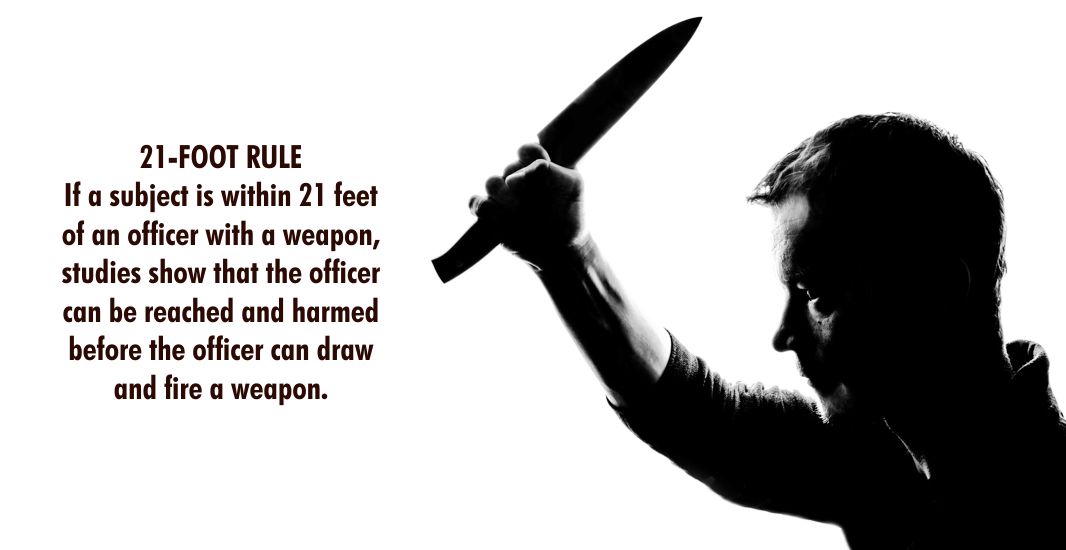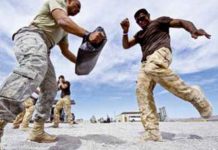PoliceOne.com Editors Note: For the record, the 21-Foot Rule, when accurately stated, says that in the time it takes the average officer to recognize a threat, draw his sidearm and fire 2 rounds at center mass, an average subject charging at the officer with an edged weapon can cover a distance of 21 feet. Thus, when dealing with an edged-weapon wielder at anything less than 21 feet you need to have your gun out and ready to shoot before he starts rushing you or else you risk being set upon and injured or killed before you can draw your sidearm and effectively defeat the attack.
In Part 1 of this special series we reported on how the 21-Foot Rule, one of the core training components of edged-weapon defense, stands up when assessed against landmark findings about action-reaction times documented by the Force Science Research Center at Minnesota State University-Mankato. We explained:
- Because of misinterpretation, the 21-Foot Rule has been dangerously corrupted, but
- When properly understood, the Rule is still valid in certain circumstances.
Now in this final installment of our 2-part series we discuss additional conclusions regarding edged-weapon defense, namely:
3. For many officers and situations, a 21-foot reactionary gap is not sufficient.
4. Weapons that officers often think they can depend on to defeat knife attacks can’t be relied upon to protect them in many cases.
5. Training in edged-weapon defense should by no means be abandoned.
Here’s what FSRC’s executive director and selected members of the Center’s National and Technical Advisory Boards have to say on these topics:
3. MORE DISTANCE. “In reality, the 21-Foot Rule–by itself–may not provide officers with an adequate margin of protection,” says Dr. Bill Lewinski, FSRC’s executive director. “It’s easily possible for suspects in some circumstances to launch a successful fatal attack from a distance greater than 21 feet.”
Among other police instructors, John Delgado, retired training officer for the Miami-Dade (FL) PD, has extended the 21-Foot Rule to 30 feet. “Twenty-one feet doesn’t really give many officers time to get their gun out and fire accurately,” he says. “Higher-security holsters complicate the situation, for one thing. Some manufacturers recommend 3,000 pulls to develop proficiency with a holster. Most cops don’t do that, so it takes them longer to get their gun out than what’s ideal. Also shooting proficiency tends to deteriorate under stress. Their initial rounds may not even hit.”
Beyond that, there’s the well-established fact that a suspect often can keep going from momentum, adrenalin, chemicals and sheer determination, even after being shot. “Experience informs us that people who are shot with a handgun do not fall down instantly nor does the energy of a handgun round stop their forward movement,” states Chris Lawrence, team leader of DT training at the Ontario (Canada) Police College and an FSRC Technical Advisory Board member. Says Lewinski: “Certain arterial or spinal hits may drop an attacker instantly. But otherwise a wounded but committed suspect may have the capacity to continue on to the officer’s location and complete his deadly intentions.”
That’s one reason why tactical distractions, which we’ll discuss in a moment, should play an important role in defeating an edged-weapon attack, even when you are able to shoot to defend yourself.
“When working with bare-minimum margins, any delay in an officer responding to a deadly threat can equate to injury or death,” reinforces attorney and use-of-force trainer Bill Everett, an FSRC National Advisory Board member. “So the officer must key his or her reaction to the first overt act indicating that a lethal attack is coming.
“More distance and time give the officer not only more tactical options but also more opportunity to confirm the attacker’s lethal intention before selecting a deadly force response.”
4. MISPLACED CONFIDENCE. Relying on OC or a Taser for defeating a charging suspect is probably a serious mistake. Gary Klugiewicz, a leading edged-weapon instructor and a member of FSRC’s National Advisory Board, points out that firing out Taser barbs may be an effective option in dealing with a threatening but STATIONARY subject. But depending on this force choice to stop a charging suspect could be disastrous.
With fast, on-rushing movement, “there’s a real chance of not hitting the subject effectively and of not having sufficient time” for the electrical charge–or for a blast of OC–to take effect before he is on you, Klugiewicz says.
Lewinski agrees, adding: “A rapid charge at an officer is a common characteristic of someone high on chemicals or severely emotionally disturbed. More research is needed, but it appears that when a Taser isn’t effective it is most often with these types of suspects.”
Smug remarks about offenders foolishly “bringing a knife to a gunfight” betray dangerous thinking about the ultimate force option, too. Some officers are cockily confident they’ll defeat any sharp-edged threat because they carry a superior weapon: their service sidearm. This belief may be subtly reinforced by fixating on distances of 21 or 30 feet, as if this is the typical reaction space you’ll have in an edged-weapon encounter.
The truth is that where edged-weapon attacks are concerned, “close-up confrontations are actually the norm,” points out Sgt. Craig Stapp, a firearms trainer with the Tempe (AZ) P.D. and a member of FSRC’s Technical Advisory Board. “A suspect who knows how to effectively deploy a knife can be extremely dangerous in these circumstances. Even those who are not highly trained can be deadly, given the close proximity of the contact, the injury knives are capable of, and the time it takes officers to process and react to an assault.
“At close distances, standing still and drawing are usually not the best tactics to employ and may not even be possible.” At a distance of 10 feet, a subject is less than half a second away from making the first cut on an officer, Lewinski’s research shows. Therefore, rather than relying on a holstered gun, officers must be trained in hands-on techniques to deflect or delay the use of the knife, to control it and/or to remove it from the attacker’s grasp, or to buy time to get their gun out. These methods have to be simple enough to be learned by the average officer.
Two techniques that bear reinforcement are illustrated in the well-known training video “Surviving Edged Weapons”, for which Gary Klugiewicz was a technical consultant. One is a deflection technique called Sweep and Disengage. The other is a tactic for controlling the attacker’s weapon hand, called by the acronym G.U.N. (Grab…Undo…Neutralize).
Stapp strongly believes that training in edged-weapon defense should prepare an officer to deal psychologically with getting cut or stabbed, a realistic probability with lag time, close encounters and desperate control attempts. “Officers need to be trained to continue to fight,” Stapp says. “They will not have time to stop and assess how severe the wound is. You don’t want them in the mind-set, ‘I’ve been cut, I’m going to die.’ They must remain focused on stopping the attack, taking out the guy who is the threat to them.”
Checking yourself over for injury after the offender is subdued is important, too, Klugiewicz says. “Some survivors of edged-weapon attacks report that they were not aware of being cut or stabbed when the injury occurred. They thought they had just been punched and didn’t realize what really happened until later.”
5. TRAINING. “Assuming it is presented accurately and in context with the many variables that shape knife encounters, the 21-Foot Rule can be a valuable training aid,” Lewinski says. “As a role-playing exercise, it provides a dramatic and memorable demonstration of how fast an offender can close distance, and it can motivate officers to improve their performance skills.”
Experiment with it and you may conclude, like Delgado, that 21 feet is not enough of a safety margin for your troops.
You might also use 21-Foot Rule exercises to test tactical methods for imposing lag time on offenders in order to buy more reaction time for officers. These could range from using or creating obstacles (standing behind a tree or shoving a chair between you and the offender) to moving yourself strategically. You’re probably familiar with the Tactical L, for example, in which an officer moves laterally to a charging offender’s line of attack. With the right timing, this surprises and slows the attacker as he processes the movement and scrambles to redirect his assault, and gives the officer opportunity to draw and get on target.
Lewinski favors a variation called the Tactical J. Here, instead of moving 90 degrees off line, the officer moves obliquely forward at a 45-degree angle to the oncoming offender. “This tends to be more confusing to the suspect and requires more of a radical change on his part to come after you,” Lewinski says. “But the timing has to be such that the suspect is fully committed to his charge and can’t readily adjust to what you’ve done. That takes lots of practice with a wide variety of training partners.”
If nothing else, training with the 21-Foot Rule will help officers better estimate just how far 21 feet is. Without a good deal of practice, most can’t accurately gauge that distance, Lewinski says, and thus tend to sabotage appropriate defensive reactions.
Don’t forget, though, that most edged-weapon attacks are “up close and personal.” That means training must include effective empty-hand-control techniques, close quarters shooting drills and weapon retention. “We need to develop the ability to draw our sidearm, get on target and GET HITS extremely fast,” while moving as a diversionary measure if possible, says Stapp. “Close-range shooting–under 10 feet–will most effectively be accomplished when an officer has developed the ability to get on target ‘by feel,’ without using his sights.”
Lewinski also recommends drills to imprint rapid reholstering techniques. Reholstering may become necessary if there’s a sudden change in threat level–say the offender throws his weapon down and is no longer presenting an imminent threat justifying deadly force–and the officer needs both hands free to deal with him.
There’s little doubt that the “knife culture” and related attacks on officers are dangerously flourishing. Edged-weapon assaults are a staple of the news reports of police incidents from across the U.S. and Canada on the website of FSRC’s strategic partner, PoliceOne.com. Recently an officer in New York City was slashed in the face during a fight that broke out on a man-with-a-gun call…in Ohio, a state trooper fatally shot a berserk motorist who charged him with a hatchet…another offender, who called 911 in Pennsylvania to report he was having a heart attack, ended up shot 13 times and killed after commands and OC failed to stop him from lunging at a trooper with a chain saw…in Calgary (Ont.) a blood-soaked man waved a bloody butcher knife over his head and charged at constables who responded to a domestic…a suspected rapist attacked a Chicago detective with a screwdriver after luring him into an interrogation room by asking for a cigarette…in the reception area of a California prison, an inmate serving time for trying to kill a cop stabbed a correctional officer to death with a shank…in Idaho, an out-of-control teenager punched holes in the walls of his house with a 15-inch bayonet, then turned on a responding officer with the blade and sliced his uniform before the cop shot him….
“Given today’s environment, rather than draw back on edged-weapon training, officers and agencies should be expanding it,” Lewinski declares. “Edged-weapon attacks are serious and should be taken seriously by trainers, officers and administrators alike. Finding out what works best in the way of realistic tactical defenses and then training those tactics as broadly as possible has never been more needed.”
FSRC is currently involved in additional research on the dynamics of edged-weapon confrontations and plans a major report on its findings before the end of this year.
From www.forcescience.org





